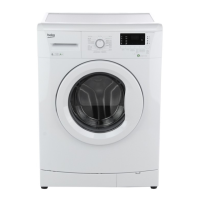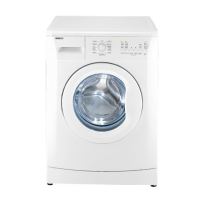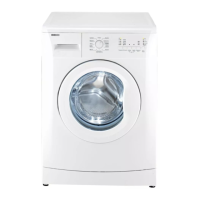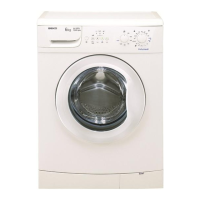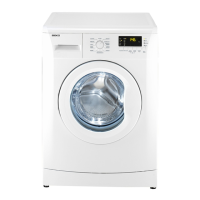Do you have a question about the Beko WMB 61232 PL PTM and is the answer not in the manual?
| Power consumption (off) | 0.25 W |
|---|---|
| Power consumption (standby) | 1 W |
| Water consumption per cycle | 40 L |
| Energy consumption washing per cycle | 0.717 kWh |
| Washing class | A |
| Annual water consumption washing | 8800 L |
| Annual energy consumption washing | 164 kWh |
| Drum capacity | 6 kg |
| Cycle time (max) | 160 min |
| Delay start (max) | 19 h |
| Residual moisture | 53 % |
| Spin-drying class | B |
| Maximum spin speed | 1200 RPM |
| Noise level (spin) | 72 dB |
| Noise level (wash) | 59 dB |
| Delayed start timer | Yes |
| Number of washing programs | 15 |
| Door hinge | Left |
| Control type | Buttons, Rotary |
| Loading type | Front-load |
| Product color | White |
| Appliance placement | Freestanding |
| Depth | 450 mm |
|---|---|
| Width | 600 mm |
| Height | 840 mm |
| Weight | 62000 g |
Provides essential safety precautions for operating the washing machine.
Specifies the intended purpose and limitations of the washing machine.
Outlines measures to ensure children's safety around the appliance.
Details about packaging materials and their disposal.
Instructions for environmentally friendly disposal of the old appliance.
Information on the appliance's compliance with WEEE regulations.
Identifies the main components and parts of the washing machine.
Lists all items included in the product packaging.
Provides detailed technical data and specifications for the appliance models.
Guides on selecting a suitable and safe place for machine installation.
Steps to remove securing elements before operation.
Instructions for removing transit bolts to prevent damage.
Details on how to connect the machine to the water supply.
Guides on correctly connecting the drain hose for water discharge.
Instructions on leveling the machine for stable and quiet operation.
Information on safe and proper electrical hook-up for the appliance.
Guidance on separating laundry based on fabric, color, and soiling.
Steps for preparing clothes before placing them in the machine.
Tips for economical and environmentally friendly washing.
Procedures to follow before the first wash cycle.
Information on determining the optimal amount of laundry per cycle.
Instructions for properly loading clothes into the drum.
Guidance on selecting and adding detergents and softeners.
Advice for optimizing wash performance and resource usage.
Identifies and explains the functions of the appliance's control panel.
Steps to take before starting a wash cycle.
How to choose the appropriate wash program for different laundry types.
Description of standard wash cycles available on the machine.
Overview of special wash programs for specific needs.
Explains programs like Rinse, Spin + Drain.
How to adjust the water temperature for wash cycles.
Guidance on selecting the appropriate spin speed for drying.
A table detailing programs, loads, and resource consumption.
Explains how to use extra features like Rinse Plus or Anti-Creasing.
Steps for initiating a selected wash cycle.
How to activate and deactivate the safety lock for children.
Monitoring the current stage of the selected wash cycle.
Explanation of the door locking mechanism and its indicators.
Modifying settings like temperature or spin speed mid-cycle.
Steps to abort a running wash cycle.
What to expect and do when a wash cycle is completed.
Information about the appliance's energy-saving standby function.
Concise steps to prepare the appliance for operation.
A brief guide to selecting wash programs.
Quick steps for choosing additional wash features.
Simple instructions to begin a wash cycle.
How to adjust settings during an active program.
A quick method to stop an ongoing wash cycle.
Instructions for cleaning the dispenser drawer to prevent buildup.
Steps for maintaining the drum and door seal cleanliness.
How to clean the exterior surfaces and control interface.
Guide to cleaning filters that prevent debris from entering the machine.
Procedures for removing residual water and cleaning the pump filter.
Solutions for issues preventing program initiation.
Explanation for residual water after production tests.
Troubleshooting steps for leaks at the base of the machine.
Steps to resolve issues with the machine not taking in water.
Solutions for problems related to water not being discharged.
Causes and remedies for excessive vibration or noise.
Reasons for unexpected program interruption.
Addresses issues where water is immediately drained.
Clarification on why water level might not be visible.
Solutions for when the loading door remains locked.
